The digital product economy is experiencing explosive growth, setting the stage for 2025 to be the biggest year yet for creators, entrepreneurs, and businesses. Selling digital goods online has never been more accessible or profitable.
With so many options available, choosing the right platforms to sell digital products can feel overwhelming. This guide uncovers the top 10 solutions, breaking down their standout features, pricing models, and unique benefits.
From industry-leading marketplaces to innovative newcomers, you’ll discover the tools and trends shaping successful digital sales. Ready to maximize your profits and find the perfect match for your business? Let’s dive in.
The Digital Product Sales Landscape in 2025
The world of platforms to sell digital products is rapidly evolving, with 2025 set to be a landmark year for creators and businesses. As digital entrepreneurship accelerates, understanding the current landscape is key to making informed decisions. Whether you’re launching your first ebook or scaling a SaaS empire, knowing what’s trending, what buyers want, and what challenges lie ahead will help you succeed.
Market Growth and Trends
The market for platforms to sell digital products is booming. By 2025, the global digital goods market is projected to surpass $500 billion, driven by surging demand for ebooks, courses, templates, music, and software. The rise of solopreneurs and creators has fueled this growth, as more people monetize their skills and knowledge online.
All-in-one, frictionless platforms are now a top priority, with AI-powered tools and automation becoming standard. Globalization is also shaping the market, as platforms enable cross-border sales and manage complex tax compliance. If you want a deeper dive into the top choices, check out this Best websites to sell digital products resource for a comprehensive comparison.
Key Features Buyers and Sellers Demand
When evaluating platforms to sell digital products, both buyers and sellers have a clear wish list. Instant digital delivery, secure payment processing, and flexible pricing models are just the beginning. Discoverability—either via built-in audiences or robust SEO—can make or break sales potential.
Analytics, sales tracking, and customer management are now expected. Transparent pricing and low transaction fees are non-negotiable, especially for creators scaling up. Seamless integrations with marketing tools and automation platforms help sellers nurture leads and boost repeat business. For example, Systeme’s free plan supports unlimited emails to up to 2,000 contacts, making it attractive for growing brands.
Challenges in Choosing the Right Platform
Selecting the best platforms to sell digital products isn’t always straightforward. Balancing transaction fees, feature sets, and audience reach can be tricky. Some platforms offer massive exposure but charge high commissions, while others grant full control but require you to build your own audience from scratch.
Global payments, tax compliance, and payout restrictions add further complexity. Customization often comes at the cost of ease of setup. For instance, Creative Market charges a 40%+ commission but provides access to millions of potential buyers, making the tradeoff worth it for some creators.
The Shift Toward Automation and Passive Income
Modern platforms to sell digital products are shifting toward automation and passive income generation. Creators want systems that handle sales, fulfillment, and even marketing with minimal manual input. Integrated email marketing, sales funnels, and membership features are increasingly common.
Recurring revenue models—like subscriptions and memberships—help smooth income streams. Lemon Squeezy, for instance, manages global tax compliance as Merchant of Record, allowing creators to focus on growth instead of paperwork. This automation trend is transforming how digital businesses operate in 2025.
The Importance of Audience Ownership and Branding
As competition grows, platforms to sell digital products are emphasizing tools for audience ownership and branding. Building a loyal customer base is more valuable than ever, and platforms that allow custom domains, branded storefronts, and email list building are in high demand.
Owning your audience means you can nurture relationships, launch new products, and drive repeat sales without relying solely on marketplace traffic. Tools like HubSpot and Kit give you free custom websites and email automation, empowering you to take control of your brand and your future.
Top 10 Platforms to Sell Digital Products in 2025
Choosing the right platforms to sell digital products is critical for creators and entrepreneurs aiming to maximize revenue and streamline the sales process in 2025. With so many options, it can be overwhelming to identify which platforms fit your business model, product type, and branding needs.
Let’s break down the top 10 platforms to sell digital products this year, with a focus on features, pricing, and real-world use cases. If you’re looking for an in-depth comparison, you might also find Best platforms to sell digital products in 2025 helpful for further insights.
CreateSell
CreateSell stands out among platforms to sell digital products by offering an all-in-one ecosystem designed to help you validate, build, and automate your digital product business. Its unique approach combines education, trend analysis, and actionable guidance.
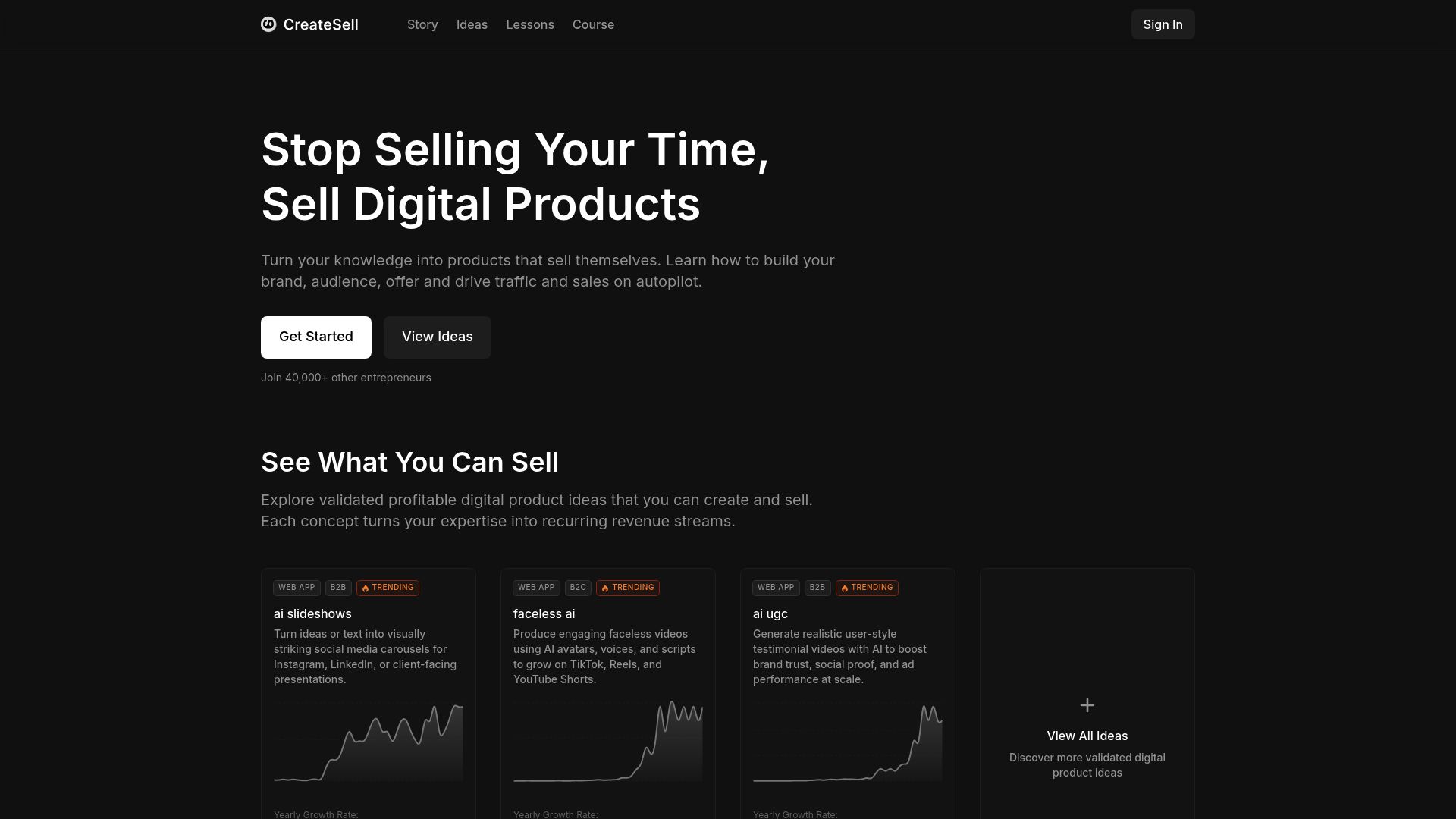
Pricing: Course/membership model, with pricing details provided upon signup.
Core Features:
- Digital product idea validation
- Step-by-step course modules
- Market and trend analysis
- Automation playbooks
- Community of 40,000+ entrepreneurs
Key Benefits:
- Data-driven product validation
- Focus on recurring revenue
- Access to trending AI-powered opportunities
- Supportive peer network
Ideal For: Aspiring entrepreneurs, coaches, consultants, and professionals seeking to shift from trading time to building scalable digital products.
Pros:
- Comprehensive ecosystem (education, community, tools)
- Automation-centric workflows
- Trusted by thousands of creators
Cons:
- Requires upfront time investment
- Pricing isn’t fully transparent until signup
Example: Users leverage CreateSell’s AI insights to identify in-demand digital products and automate sales, achieving sustainable passive income.
If you’re looking for platforms to sell digital products that guide you from idea to execution, CreateSell is a top contender.
Payhip
Payhip is one of the most approachable platforms to sell digital products, especially for those starting out. Its free plan means you can launch without upfront costs, making it accessible to a wide range of creators.
Pricing: Free plan with 5% transaction fee, paid plans reduce fees.
Core Features:
- Unlimited digital product uploads
- Customizable storefronts
- Sales pages and checkout optimization
- Course and membership support
Key Benefits:
- Immediate payouts via Stripe or PayPal
- No revenue cap on free plan
- Full access to all features regardless of plan
Ideal For: Digital product entrepreneurs, authors, designers, and course creators.
Pros:
- Beginner-friendly setup
- Supports all digital product types
- Handles EU VAT and tax compliance
Cons:
- 5% fee on free plan can add up
- Branding options are limited compared to advanced solutions
Example: Creators sell ebooks, templates, or online courses on Payhip with no upfront investment, making it one of the easiest platforms to sell digital products for beginners.
Gumroad
Gumroad has built a reputation as one of the go-to platforms to sell digital products for indie creators. Its focus is on simplicity and accessibility, with no monthly fees and a supportive community.
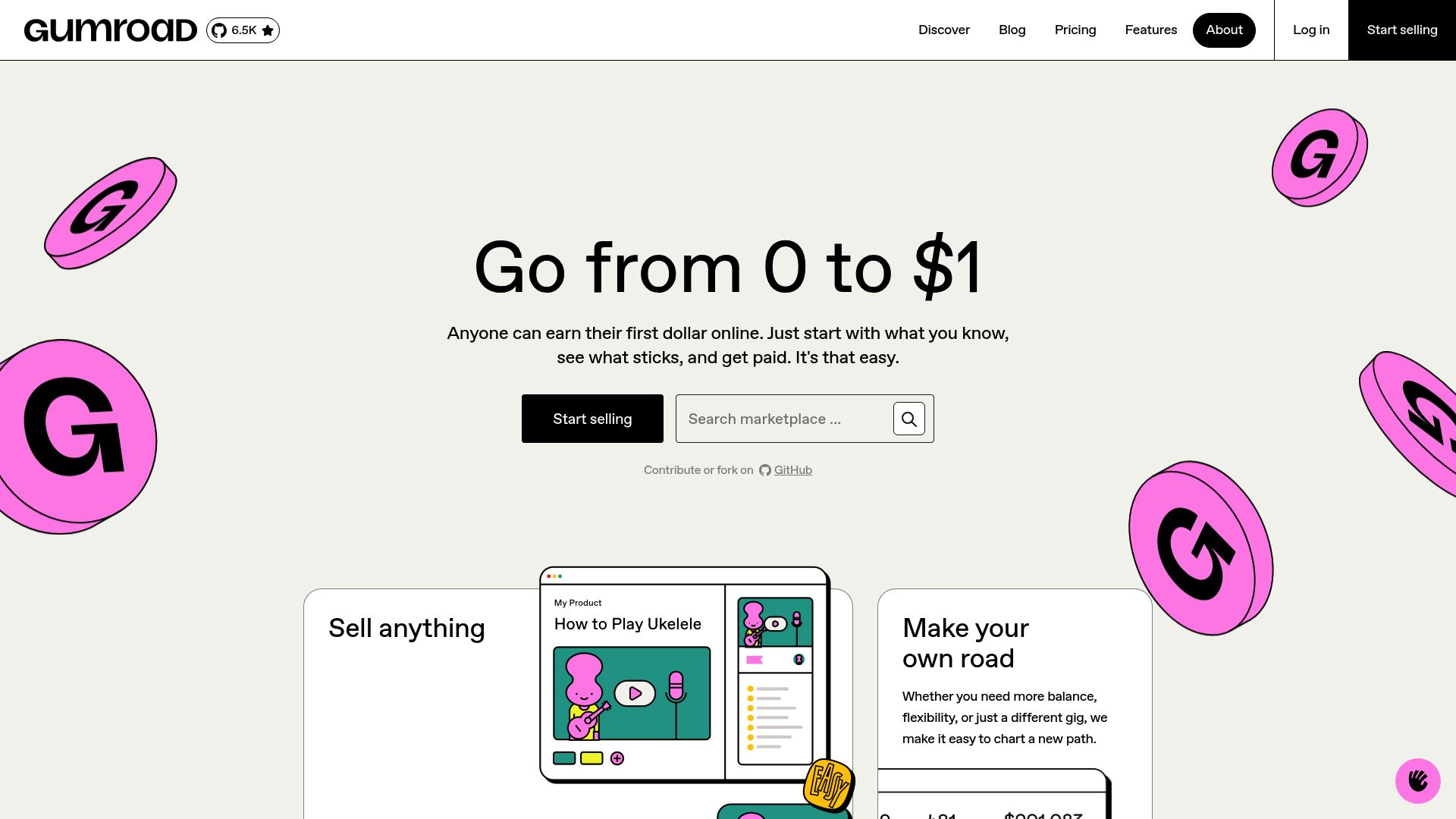
Pricing: 10% per sale plus payment processing.
Core Features:
- Sell ebooks, music, software, and more
- Simple, fast product setup
- Marketplace exposure for discoverability
Key Benefits:
- No monthly costs
- Global payout options
- User-friendly analytics dashboard
Ideal For: New creators, indie authors, musicians, and artists.
Pros:
- Quick to launch products
- Large, active creator community
- Wide variety of digital formats supported
Cons:
- Higher transaction fees than some competitors
- Storefront customization is limited
Example: Indie authors and musicians use Gumroad to launch digital products with minimal barriers, making it a favorite among platforms to sell digital products for newcomers.
Etsy
Etsy is a powerhouse among platforms to sell digital products, especially for design-focused and creative goods. Its built-in audience and search-driven discovery make it an attractive choice for digital artists.
Pricing: $0.20 listing fee per item, 6.5% transaction fee, and payment processing fees.
Core Features:
- Marketplace for digital downloads (templates, printables, planners)
- SEO-optimized product listings
- Easy digital file delivery
Key Benefits:
- Access to millions of potential buyers
- Trusted payment and delivery system
- Strong community support
Ideal For: Designers, crafters, and creators of printables, planners, and digital art.
Pros:
- Massive audience and global reach
- Search-powered discoverability
- Simple setup for digital products
Cons:
- Intense competition
- Limited branding customization
- Fees can accumulate quickly
Example: Sellers offer Canva templates or Lightroom presets to a worldwide audience, making Etsy one of the most established platforms to sell digital products.
Lemon Squeezy
Lemon Squeezy is quickly gaining traction as one of the most innovative platforms to sell digital products, especially for software and SaaS. It stands out for its built-in tax compliance and developer-friendly features.
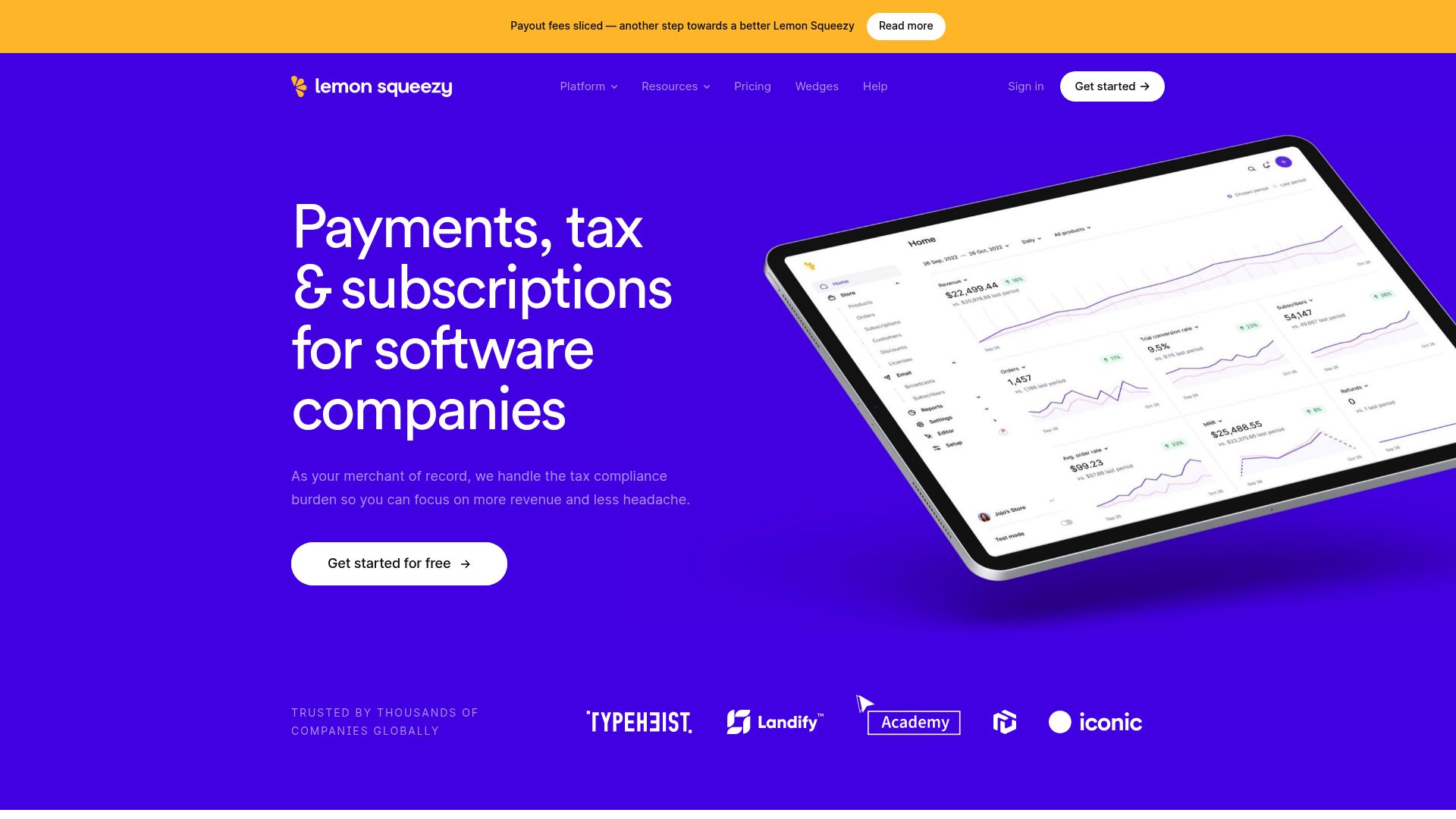
Pricing: 5% + $0.50 per sale; 0% payout fee for US banks, 1% for non-US.
Core Features:
- Sell SaaS, software, and digital licenses
- Handles global VAT and tax as Merchant of Record
- Automated license key delivery
Key Benefits:
- Worry-free compliance and fraud protection
- Fast, developer-friendly payouts
- Built-in email marketing for up to 500 subscribers
Ideal For: Software developers, SaaS founders, and digital creators selling globally.
Pros:
- No monthly fees
- Handles global tax complexities
- Supports subscriptions and licenses
Cons:
- Limited storefront customization
- International payouts may incur fees
Example: Indie developers use Lemon Squeezy to sell SaaS subscriptions worldwide, making it one of the most reliable platforms to sell digital products for software businesses.
Kit (ConvertKit Commerce)
Kit, formerly ConvertKit Commerce, is built for creators who prioritize email marketing. As one of the platforms to sell digital products focused on audience ownership, it helps creators monetize directly through email.
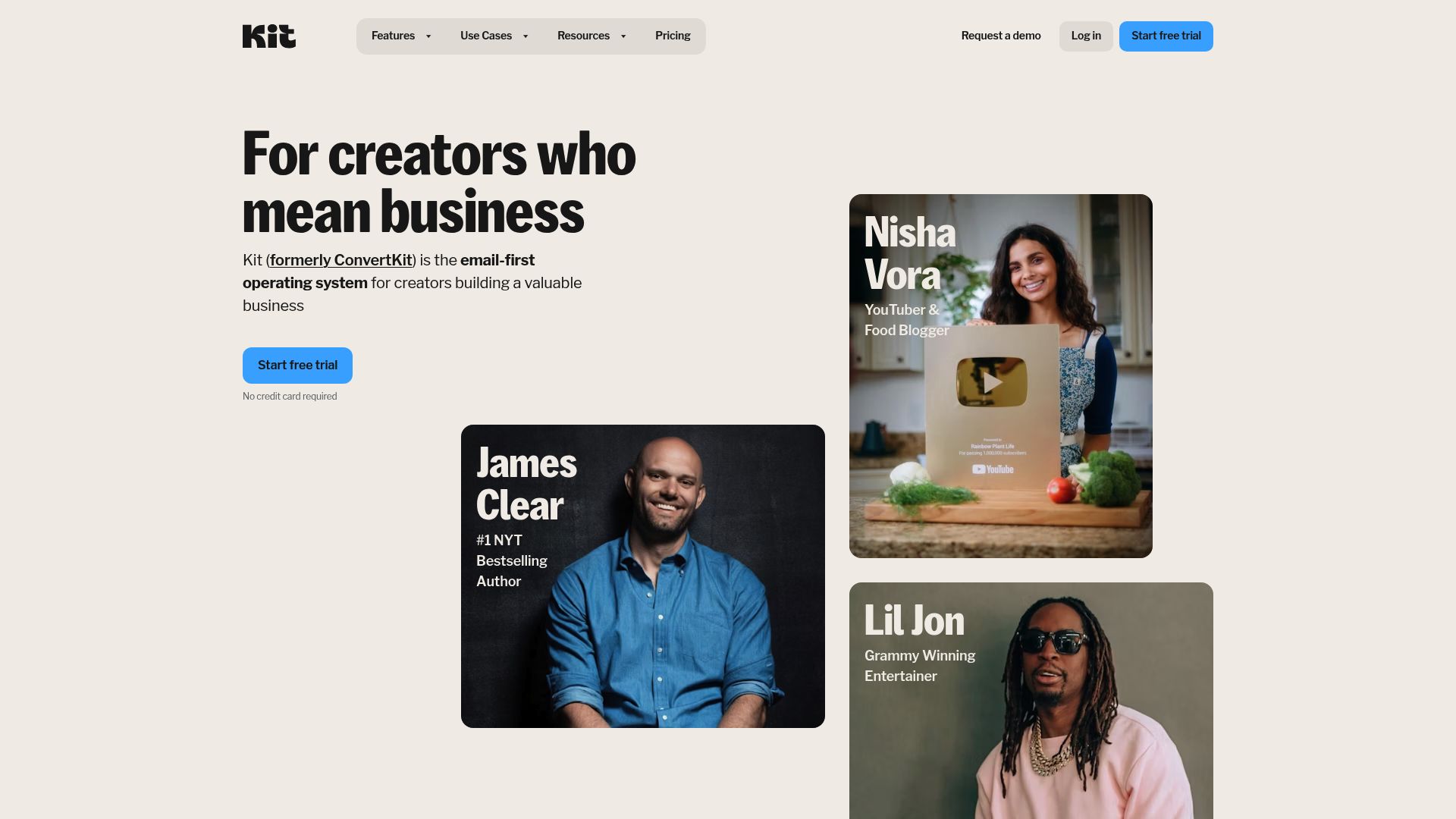
Pricing: Free plan (3.5% + $0.30 per sale); paid plans reduce fees.
Core Features:
- Sell digital downloads and paid newsletters
- Unlimited landing pages
- Email marketing for up to 1,000 subscribers
Key Benefits:
- Email-first sales approach
- Community support for creators
- Recurring revenue through subscriptions
Ideal For: Writers, educators, and newsletter creators.
Pros:
- Simple setup, no website required
- Integrated email marketing and commerce
- Supports paid memberships
Cons:
- Commerce features limited to select countries
- Advanced sales tools are limited
Example: Writers monetize their audience with paid newsletters, using Kit as one of the most streamlined platforms to sell digital products to their subscribers.
Creative Market
Creative Market is a leading marketplace for design assets, making it one of the most specialized platforms to sell digital products for creatives. Its curated categories and large audience offer high visibility for sellers.
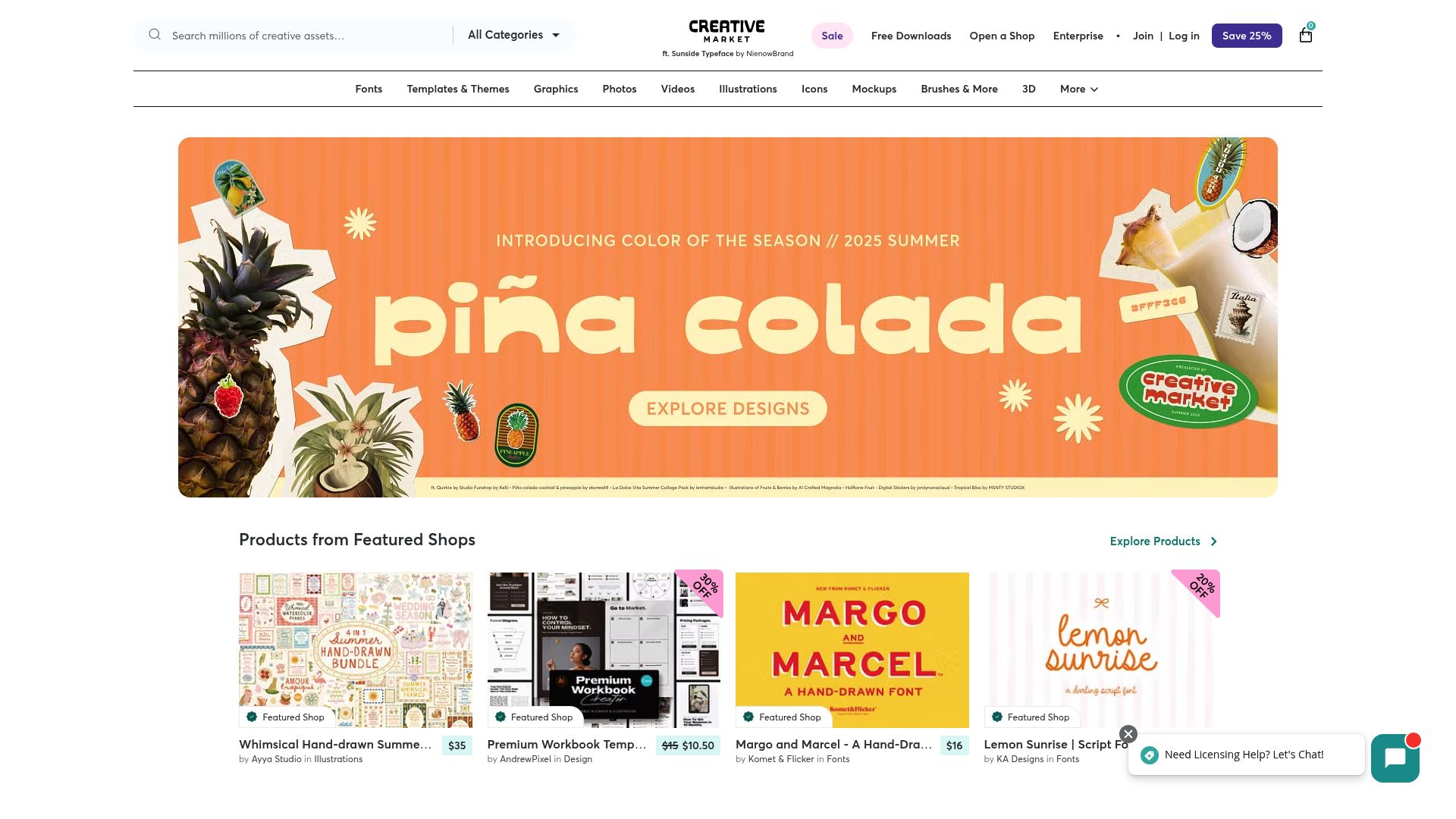
Pricing: 40-50% commission per sale.
Core Features:
- Marketplace for fonts, graphics, photos, and templates
- Curated categories for easy discovery
- Passive sales opportunities
Key Benefits:
- Access to 8+ million buyers
- High-visibility placements for top products
- Simple onboarding process
Ideal For: Designers, illustrators, photographers, and digital asset creators.
Pros:
- Huge, engaged audience
- Potential for passive income
- Easy to list and manage products
Cons:
- High commission rates
- Highly competitive categories
- Limited control over customer relationship
Example: Designers generate full-time or side income selling templates and graphics, cementing Creative Market’s place among platforms to sell digital products for creatives.
HubSpot Free Marketing Hub
HubSpot Free Marketing Hub offers a robust suite of tools, positioning itself as one of the most comprehensive platforms to sell digital products for small businesses and entrepreneurs wanting all-in-one marketing.
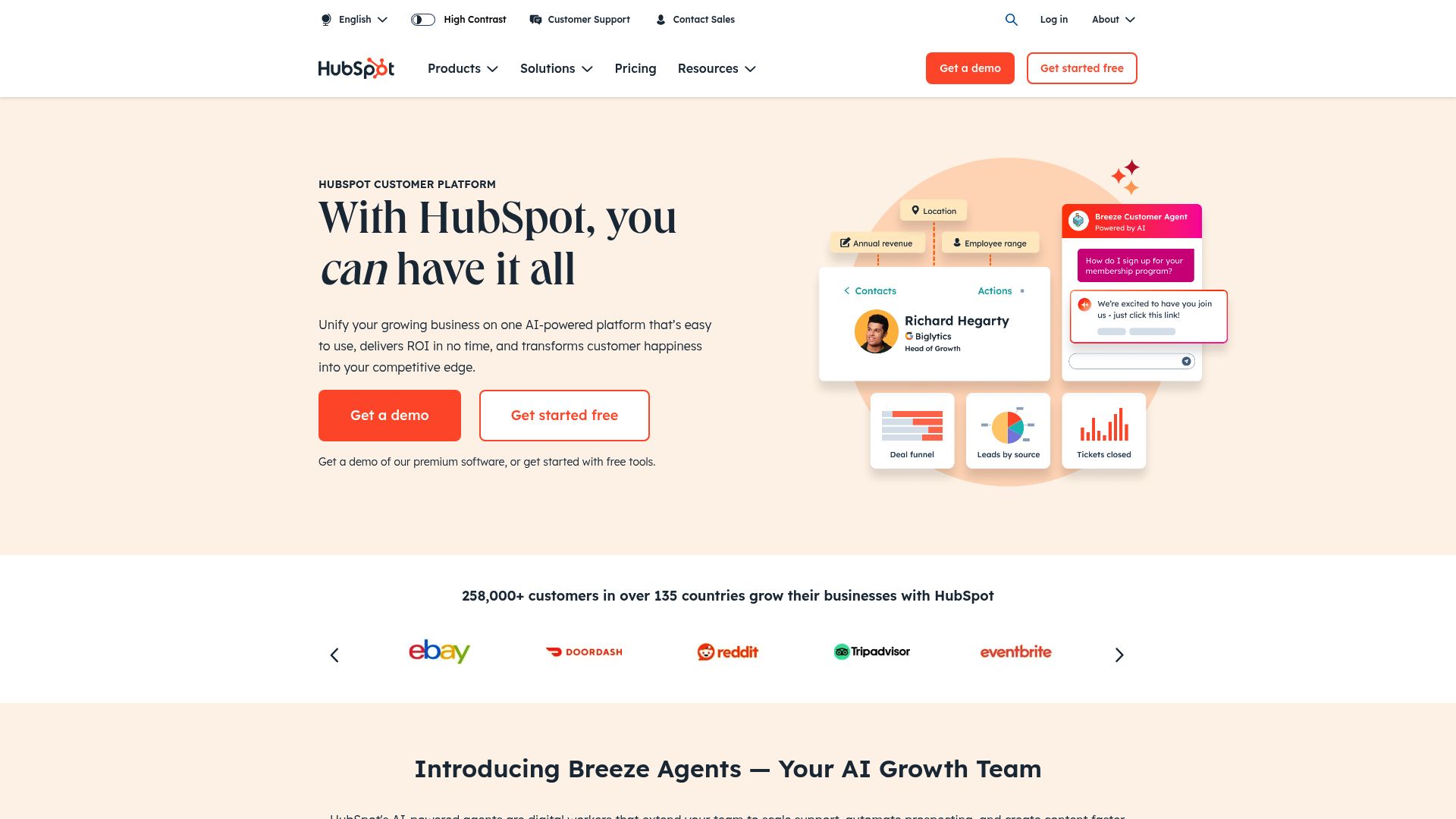
Pricing: Free plan; 0.75% platform fee plus Stripe payment fees.
Core Features:
- Custom website builder
- Payment links and sales funnels
- Email campaigns and built-in CRM
Key Benefits:
- All-in-one marketing and sales suite
- Automation tools for nurturing leads
- Supports both digital and physical products
Ideal For: Small businesses, digital entrepreneurs, and creators needing integrated marketing.
Pros:
- Free to start with advanced features
- Robust customer management
- Automation for growth
Cons:
- Some features restricted to paid plans
- Upsells to higher tiers
Example: Entrepreneurs launch digital storefronts and manage customer relationships, making HubSpot one of the most versatile platforms to sell digital products.
Amazon KDP (Kindle Direct Publishing)
Amazon KDP is a dominant force among platforms to sell digital products, especially for authors and publishers. Its global reach and integration with Kindle devices make it a staple for ebook sales.
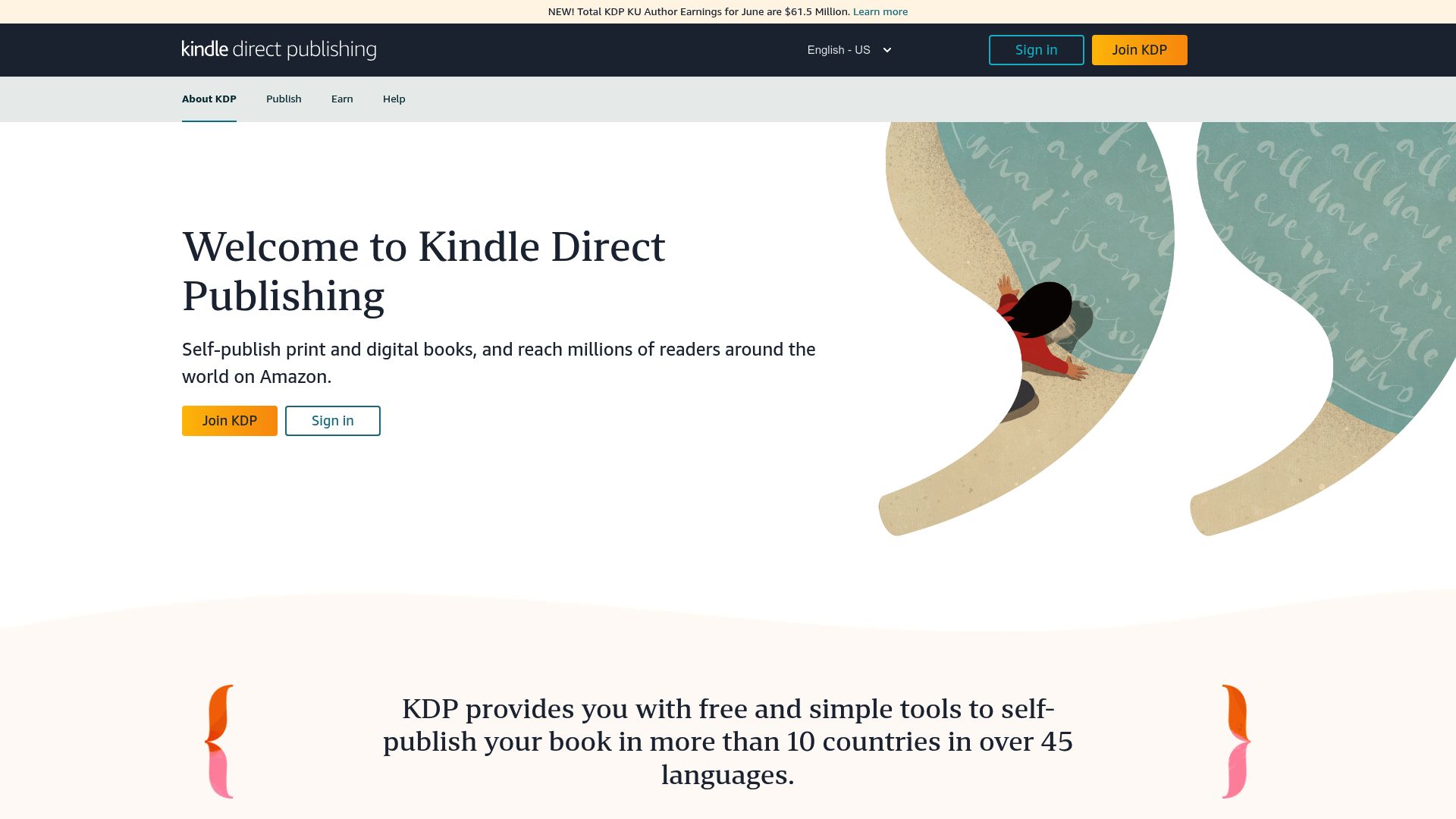
Pricing: No upfront fees; Amazon takes 30-65% royalty depending on book price and distribution.
Core Features:
- Self-publish ebooks and audiobooks
- Access to Amazon’s vast marketplace
- Formatting and promotional tools
Key Benefits:
- Reach millions of readers worldwide
- No upfront costs
- Built-in marketing and sales analytics
Ideal For: Authors, self-publishers, and anyone producing written or audio content.
Pros:
- Massive audience and global distribution
- Simple publishing workflow
- Access to promotional programs
Cons:
- High competition in popular categories
- Limited control over customer data
- Royalty rates can be restrictive
Example: Authors distribute ebooks and audiobooks to millions, making Amazon KDP a top choice among platforms to sell digital products for writers.
Systeme
Systeme is an all-in-one business platform that’s quickly rising among platforms to sell digital products. Its generous free plan and automation features make it attractive for scaling businesses.
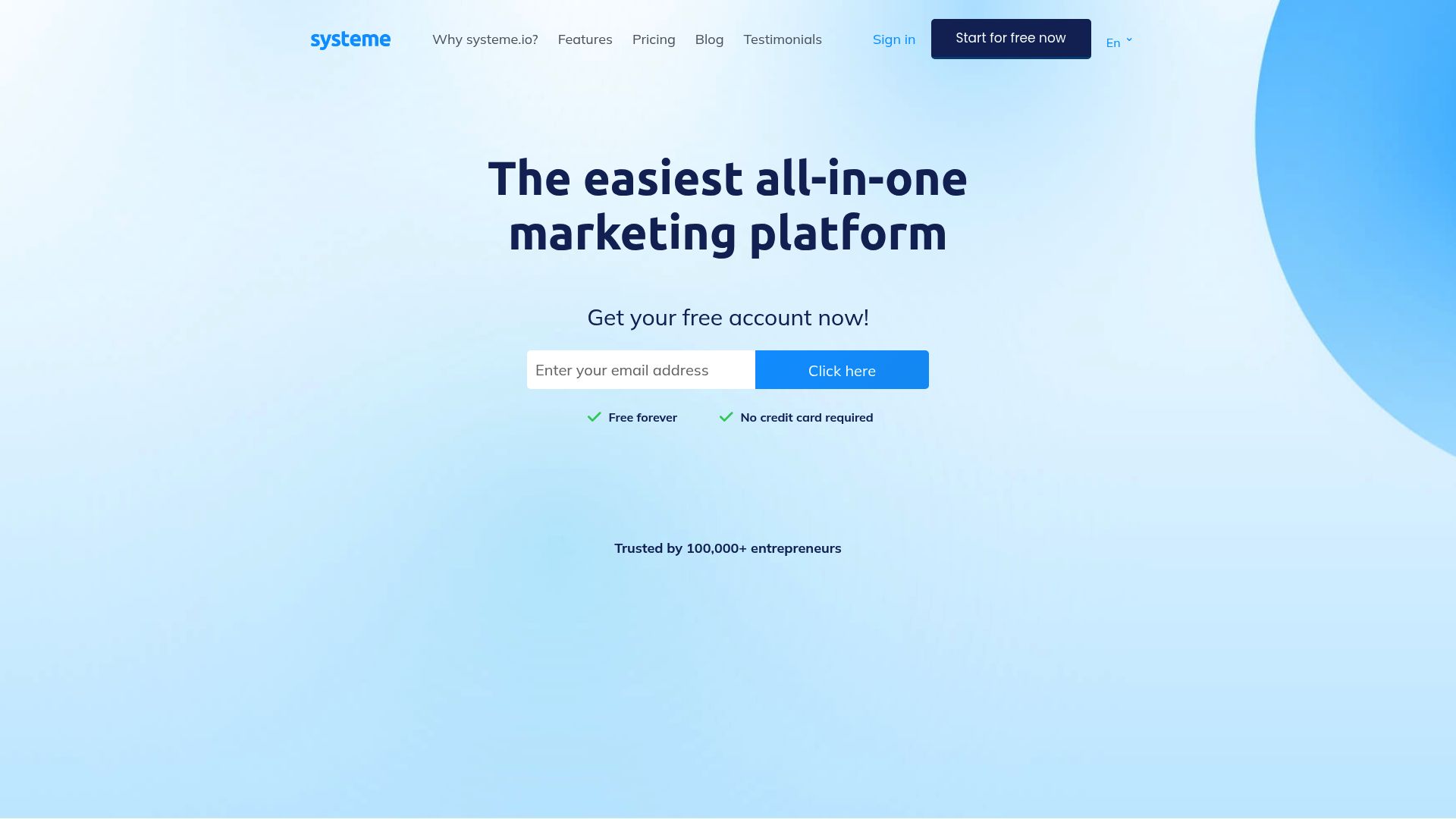
Pricing: Free plan (no platform fees; payment processor fees apply), paid plans unlock advanced features.
Core Features:
- Website and sales funnel builder
- Unlimited emails (up to 2,000 contacts on free plan)
- Online courses, memberships, affiliate management
Key Benefits:
- No platform fees on the free tier
- Robust automation and marketing tools
- Supports PayPal and Stripe payments
Ideal For: Coaches, course creators, and entrepreneurs wanting to centralize sales and marketing.
Pros:
- Unlimited students/courses on paid plans
- Full branding and customization
- Affiliate program management
Cons:
- Advanced features require paid plans
- Some learning curve for beginners
Example: Course creators automate sales and email marketing, making Systeme a go-to among platforms to sell digital products for those seeking growth and efficiency.
How to Choose the Best Platform for Your Digital Products
Finding the right platforms to sell digital products can make or break your digital business in 2025. With so many choices, it’s easy to feel overwhelmed. The ideal solution fits your product type, supports your growth, and keeps your profit margins healthy. Let’s break down what matters most so you can confidently navigate the landscape of platforms to sell digital products and set yourself up for success.
Assessing Your Product Type and Audience
Start by matching your product to the platforms to sell digital products that play to its strengths. Are you offering ebooks, courses, templates, or software? Each platform excels in different niches. For example, Etsy is perfect for creative templates and printables, while Amazon KDP dominates the ebook scene.
Understand where your target audience prefers to shop. Some buyers trust established marketplaces, while others seek out niche or branded storefronts. Research your audience’s habits before committing. For more actionable guidance, check out this How to sell digital goods guide to refine your strategy.
Taking the time to align your offering with the right audience and marketplace increases your chances of success on platforms to sell digital products.
Evaluating Fees, Payouts, and Profit Margins
Fees and payout structures can eat into your earnings if you’re not careful. Different platforms to sell digital products have various pricing models, so it’s essential to compare net profits. Here’s a simple comparison:
| Platform | Listing Fee | Transaction Fee | Payout Schedule |
|---|---|---|---|
| Gumroad | $0 | 10% | Weekly |
| Payhip | $0 | 5% (free plan) | Instant |
| Etsy | $0.20/item | 6.5% | Varies |
Always factor in payment processor fees as well. Some platforms to sell digital products offer instant payouts, while others have a delay. Review all costs before making your choice to maximize your bottom line.
Branding, Customization, and Customer Data Ownership
If brand identity matters to you, prioritize platforms to sell digital products that offer full customization. Custom domains, branded storefronts, and email list building can help you stand out and foster loyalty.
Marketplace platforms are easy to join, but you may have limited options for branding and less access to customer data. Owning your audience and having control over communication is crucial for long-term growth. Platforms like HubSpot and Systeme empower you to create a branded experience and nurture customer relationships.
Choosing platforms to sell digital products that support your branding goals will set you apart from competitors.
Automation, Integrations, and Scaling Potential
Scaling your digital business means working smarter, not harder. Seek platforms to sell digital products with built-in automation tools like sales funnels, email marketing, and membership management. These features save time and create seamless customer experiences.
Integration with third-party tools can further streamline your workflow. Systeme and Lemon Squeezy, for example, offer robust automation and scaling capabilities. Think about your long-term needs—will the platform support your growth as you add more products or expand your offerings?
Prioritize platforms to sell digital products that help automate and scale your operations for sustainable success.
Global Reach, Tax Compliance, and Legal Considerations
Selling internationally opens doors but comes with challenges. Platforms to sell digital products that handle tax compliance (like VAT or GST) and offer global payment options are essential for cross-border growth.
Review payout availability in your country and ensure the platform meets local legal requirements. Lemon Squeezy, for example, acts as Merchant of Record, simplifying global tax management. Understanding these aspects ensures your business can grow without legal headaches.
Choose platforms to sell digital products that make global sales and compliance as seamless as possible.
Future Trends: What’s Next for Digital Product Platforms?
The landscape for platforms to sell digital products is evolving at lightning speed. As we look toward the future, several key trends are set to redefine how creators, entrepreneurs, and businesses succeed online. From AI-powered innovation to new business models and global compliance, staying ahead of these shifts will be crucial for anyone aiming to maximize sales and audience reach.
AI-Powered Product Creation and Sales
Artificial intelligence is quickly becoming a core feature for platforms to sell digital products. AI tools are now helping creators automate everything from product generation to personalized marketing. Imagine using a platform that suggests trending product ideas, writes sales copy, or even builds digital assets for you.
This AI-driven transformation is already impacting IT spending worldwide, with global AI adoption expected to push IT spending beyond $5.4 trillion in 2025. Platforms that integrate AI for sales optimization, customer segmentation, and content creation will empower sellers to work smarter, not harder.
Rise of Micro-Entrepreneurs and Solopreneurs
Another defining trend is the explosion of micro-entrepreneurs using platforms to sell digital products. Solo creators and small teams are leveraging automation and niche expertise to launch profitable businesses without large overheads.
These platforms lower the barrier to entry, making it possible for a single person to manage sales, marketing, and customer relationships. As more people seek flexible, independent work, expect a surge in solopreneurs capitalizing on digital product sales. This movement is reshaping the market by emphasizing agility and personal branding.
Expansion of Subscription and Membership Models
The demand for recurring revenue streams is driving the popularity of subscription and membership features on platforms to sell digital products. Instead of one-time sales, creators now offer exclusive content, courses, and community access on a subscription basis.
This shift benefits both sellers and buyers: sellers gain predictable income, while buyers enjoy ongoing value. Platforms are expanding their toolsets to support memberships, automated renewals, and gated content. Expect to see even more robust options for creators to build loyal, paying communities around their digital offerings.
Marketplace vs. Standalone Storefront Evolution
The line between marketplaces and standalone storefronts is blurring. Many platforms to sell digital products now offer hybrid solutions that combine built-in audiences with greater branding control. Sellers can tap into massive traffic while still customizing their storefronts and nurturing direct relationships.
New features like custom domains, advanced analytics, and integrated marketing are making it easier to balance discoverability with ownership. As competition grows, platforms will continue to innovate, giving sellers more ways to stand out and connect with their ideal customers.
Regulatory Changes and Globalization
Selling digital products worldwide brings exciting opportunities, but also new challenges. Platforms to sell digital products must now adapt to changing tax laws, cross-border payments, and data privacy regulations. Automation is key—sellers want platforms that handle VAT, GST, and compliance seamlessly.
The global digital goods market is projected to reach $416.21 billion by 2030, highlighting the need for scalable, compliant solutions. As platforms evolve, expect even better tools for global sales, automated reporting, and legal peace of mind, allowing creators to focus on growth.
Now that you’ve seen what the top platforms offer for selling digital products in 2025, you’re probably thinking about the best next step for your own journey. Whether you’re just starting out or looking to scale, the right tools and guidance can make all the difference. At CreateSell, we’re all about helping you move from trading your time for money to building a business around your expertise—so you can earn more freedom and passive income. If you’re ready to turn your ideas into products and automate your sales, let’s take that first step together: Get Started